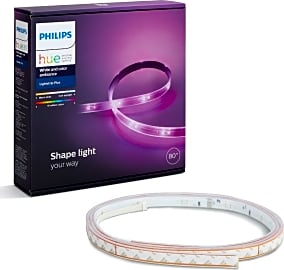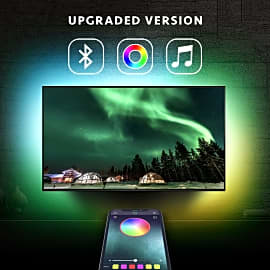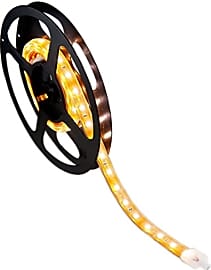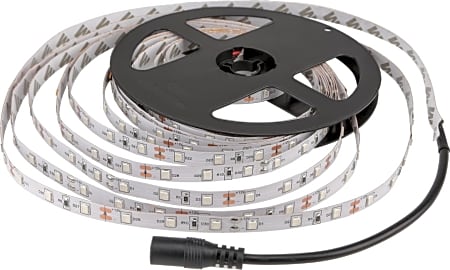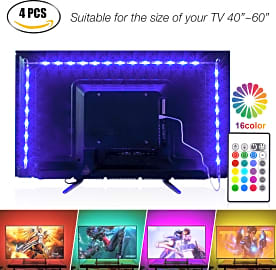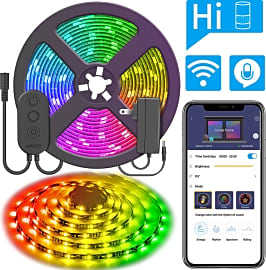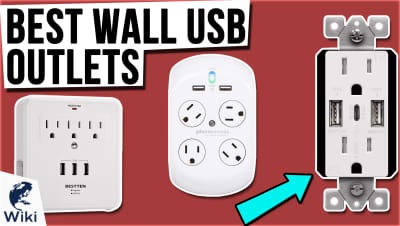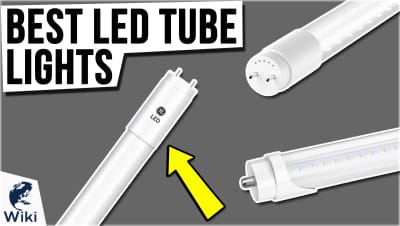The 10 Best LED Strip Lights

This wiki has been updated 39 times since it was first published in December of 2016. You can add an energy-efficient, decorative effect to almost any spot in your home or office with one of these LED strip lights. We've included both monochromatic and multicolored models, as well as some high-tech options that can connect to your smartphone via Wi-Fi or Bluetooth, enabling you to control their brightness, color, flashing pattern, and the times they’ll turn on and off. When users buy our independently chosen editorial recommendations, we may earn commissions to help fund the Wiki.
Editor's Notes
July 22, 2020:
With the lion’s share of our previous selections still proving to be great choices for the category, it was a relatively straightforward round of updates. The only two options we did decide on removing were the WenTop Safety and GE 10434, both due to availability issues. These options were replaced by the Micomlan Music Sync — an 82-foot option that’s appropriate for users looking to install large sections of feature lighting, and the Nexillumi Color Changing — which comes with a 44-button remote control and several styles of mounting hardware:
A few things to think about for this category:
Length: It might seem obvious, but the first thing you’re going to need figure out is exactly how much strip lighting you need. While some options – like the GE 10434, which we removed during this round of updates – can be as short as 12 inches, most models in this category will be at least a few feet long. Options like the Pangton Villa Kit can be less than seven feet, while alternatives like the Micomlan Music Sync are longer than 80 feet. Just how much you need will depend on the nature of your specific project.
Usually, users looking for a very particular length of strip lighting can buy a size up, and trim down to the length they need. However, some options – like the Minger DreamColor – cannot be trimmed, so keep an eye out for that. Even in the case of options that can be trimmed, there will be some variability in how precisely this can be accomplished. For example, the Micomlan Music Sync is designed to be trimmed at three-LED intervals, while some of its competitors are built with clusters of five LEDs. For most users, this difference is of little significance, but for some perfectionists it may be worth noting.
Power Source: Since this style of fixture was introduced to the industry, they’ve garnered massive popularity, not only because of their affordable price point, but also because of their simple, plug-and-play and self-adhesive designs that make installation a breeze for average homeowners. That being said, you’ll want to make sure that the unit you’re considering is compatible with the situation you have in mind.
In most cases, this boils down to making sure that you’ve got a standard 120-volt outlet available to power this fixture. However, in some situations – as in the case of the Pangton Villa Kit – these models are powered via USB. So, unless there’s already a USB port closeby, you’ll need a separately purchased USB wall outlet to get that unit running. Also, many models in this category – including the Lighting Ever Flexible – don’t come with a power adapter, which amounts to an extra cost for you, and often quite a lot of frustration, if you don't realize that it's not included until your package arrives, so keep an eye out for that.
Control: While options like the Minger DreamColor and Nexillumi Color Changing feature built-in control options, infrared remote controls tend to be the standard in this category, and are featured with many models we ranked, including the DotStone Music and Pangton Villa Kit. Advanced models like the Micomlan Music Sync and RXment Wireless feature app connectivity, and some choices – like the Philips Hue LightStrip Plus – are even compatible with smart-home systems like Alexa and Google Home.
June 30, 2019:
Thanks to their energy efficiency, color options, simple installation, and low price, LED strip lights are popular for both residential and commercial use. Many models are highly customizable, giving you control over the colors, brightness, pattern, and even the times they’ll turn on and off.
New to the list, the GE 10434 provides warm lighting that’s great for showcasing your prized possessions in a curio or china cabinet. It features a long cord that makes for easy positioning, and a handy on/off switch if you’d rather not have to unplug it. Rather than consisting of a soft, flexible strip, like most of the models featured here, this piece is unbendable, but can be attached to up to five additional ones, for those who want their lights to go the distance.
The Minger DreamColor have everything you’ll need liven up a party, including lots of color and the ability to sync with music, thanks to their high-sensitive mic. You can control them conveniently on your smartphone via the downloadable Govee Home app. This includes multi-colored flashing and single-color modes, as well as a programmable timer for turning them on and off.
The third new addition is the Nexillumi RGB, which are ideal for providing some colorful lighting behind a computer or TV screen, or for brightening up your backyard deck or patio at night. Their bendable wires make them easy to install around corners without any special cutting or connecting, and they adhere via the included 3M sticky foam tape. You can buy them with confidence, thanks to their 18-month warranty.
Leaving the list in this update are the Nexlux RGB Kit and the Topmax Bluetooth, due to issues with availability, as well as the Amir USB, due to some reports regarding quality. No matter which set you ultimately choose, take note of the voltage they use. For instance, a 24-volt strip will not work with a 12-volt power supply and can be dangerous if plugged into it. As such, it's very important to choose lights that are compatible with your power supply, and vice versa.
Special Honors
Waveform Lighting LED Strip If you want one fixed color of lights and don't need a remote control or downloadable app, look no further than this simple selection available in your choice of blue, green or red. They provide twice the diode density of many others, so they’re brighter and produce few to no dark spots between emitters. The double-sided adhesive comes pre-attached and will stick to any surface. waveformlighting.com
A Brief History Of The LED
Technically speaking, an LED is an electrical component that produces light when a current passes through it.
LED stands for light-emitting diode. Technically speaking, an LED is an electrical component that produces light when a current passes through it. Unlike a lightbulb, for example, which serves as a vacuum-sealed encasement for an internal filament that provides the actual illumination, the diode itself is what produces the light. This allows LEDs to be quite small. They are also characterized by low energy consumption, durability, and the fast speed with which they can turn on and off. All of these qualities combine to make LEDs ideal for a wide variety of applications, from flashlights to signage and more.
LEDs were first discovered in 1907 by a British engineer named Henry Joseph Round. He made the discovery by applying an electrical current to a silicon carbide crystal and witnessing the yellow light it produced. A Russian inventor named Oleg Losev was the first to publish anything significant about the phenomenon, in 1927. Little progress was made until many years later, in 1961, when two engineers at Texas Instruments made a similar discovery and filed a patent for it the following year. Those engineers were James R. Biard and Gary Pittman, and their LED actually emitted infrared light, which is not visible to the naked eye. The technology they developed is still in use today in an updated form in many TV remotes.
The first manufactured LED that emitted visible light was developed in 1962 by Nick Holoyak Jr., an engineer at General Electric. Over the next ten years, the technology would experience rapid adoption and development, with brighter and more powerful LEDs in a variety of colors being manufactured for commercial purposes. Soon, LEDs began to replace incandescent and neon indicator lights on a variety of devices, from laboratory equipment to televisions, radios, and more. They can still be found today on most appliances that use indicator lights.
Over the next several decades, many more advancements were made. Blue LEDs were introduced in 1972, though the first high-brightness version was not demonstrated until 1994. It was not until the 21st century that white LEDs were successfully developed for commercial use. With each passing year, the technology continues to get smaller, more flexible, and more affordable.
Contemporary LED Applications
While the first commercial LEDs may not have been bright enough to light up much more than a power button, today's LEDs are everywhere. From streetlights to lightbulbs, car headlights, flood lamps, and some of the brightest flashlights imaginable, their uses when it comes to keeping an area well-lit are many. Even many traffic lights are now LED-powered. There are many innovations, however, for which you might not realize LEDs are responsible.
They work well for accenting a room or outdoor area, and countless formats are available.
Decorative lighting is a huge market for LEDs. As the strip lights in our selection demonstrate, they're ideal because you can cut them into very small shapes, they have a low power draw, and they can change colors. They work well for accenting a room or outdoor area, and countless formats are available. In addition to putting a rainbow of color at your fingertips, remote controls come with many LED strips, so you can change the ambiance of a room without getting up from your seat.
Many companies use a special kind of LED technology to replace their LCD television, computer, and smartphone screens, as well. These primarily use organic compounds for their electroluminescent layer, giving them the name OLED. Most LCD screens actually use an LED backlight, but OLED technology eliminates this need. This results in several advantages over LCD technology, including the ability to show much richer black tones. They can also achieve higher contrast and be made much thinner and lighter than LCD screens.
More niche developments in LED technology have resulted in the LED tattoo, which is still in development. While we're still a bit far-off from decorative LEDs being implanted in people's skin, the innovation has great promise for medical applications. Once fully developed, a diabetic person could, for example, check their blood sugar by simply activating the tattoo in their arm. Early clinical trials have been successful in mice.
LEDs can also control bacteria and other biological systems. Advanced grow lights have been developed with the technology, for example, to increase photosynthesis production in plants. Ultraviolet LEDs can also be used to sterilize water and other substances.
Because of the versatility of the technology and the rate at which it continues to develop, it's hard to predict where LEDs will go next. I would say the sky's the limit, but they're already in heavy use in outer space.
What To Do With Your Strip Lights
If you're interested in buying some LED strip lights, but you're not sure just what you want to do with them, fear not. You have plenty of options, and if you don't like what you come up with on the first try, they're easy to reposition or apply elsewhere.
You can also use LED strips to trick out your bedroom or living room.
A great area to start with is home improvement. Strip lights are ideal for applications like under-cabinet lighting. If you're sick and tired of struggling to see what you're chopping in the kitchen, a strip of LEDs can solve that problem in one short installation. Plus, if you opt for a set that can change colors, you can adjust the vibe in your kitchen once the work is done. Glowing purple countertops are the perfect setting for a late-night snack.
You can also use LED strips to trick out your bedroom or living room. Placing them behind furniture like a couch or headboard imparts a playful glow to any space, and eliminates eye strain by placing the light source out of your line of sight. This also works well for a bar area or home theater.
LED strip lighting is also ideal for illuminating areas of your home like staircases for added safety and visibility. No matter what you do, just ensure you work safely and consider the best set of strips for the task at hand.



